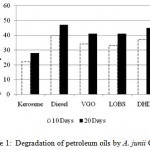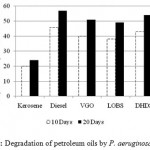How to Cite | Publication History | PlumX Article Matrix
Study of the Potential of Two Isolated Microorganisms to Degrade Various Petroleum Fractions
Sonali Sahoo, Dipa Biswas* and Sriparna Datta
Department of Chemical Technology, University of Calcutta, 92, A.P.C. Road, Kolkata - 700 009 India. Correspondence Author E-mail: dipa_bis@yahoo.com
ABSTRACT: Biodegradation of petroleum by the microorganisms in polluted site has been gaining attention from the environment clean-up point of view. Two isolated organisms Acinetobacter junii CTA3 and Pseudomonas aeruginosa OCD1 were tested for their petroleum degrading ability in liquid Bushnell-Hass broth. Both the organisms degraded higher boiling petroleum fractions more efficiently. The strain OCD1 showed better degrading ability than the strain CTA3. The highest degradation of 47% and 57% was obtained with diesel after 20 days of incubation by the organism CTA3 and OCD1 respectively. Also it was observed that, most of the oils were degraded in first 10 days of incubation for both the isolates.
KEYWORDS: Acinetobacter junii; Biodegradation; Petroleum fractions; Pseudomonas aeruginosa
Download this article as:| Copy the following to cite this article: Sahoo S, Biswas D, Datta S. Study of the Potential of Two Isolated Microorganisms to Degrade Various Petroleum Fractions. Biosci Biotech Res Asia 2011;8(2) |
| Copy the following to cite this URL: Sahoo S, Biswas D, Datta S. Study of the Potential of Two Isolated Microorganisms to Degrade Various Petroleum Fractions. Biosci Biotech Res Asia 2011;8(2). Available from: https://www.biotech-asia.org/?p=9668 |
Introduction
Petroleum is the great source of various essential products used in our modern life; however, despite its important uses, petroleum hydrocarbon results in environmental pollution due to industrial waste, transport and storage accidents and it is a serious global problem. This contamination are hazardous to the health of plants and are also carcinogenic, mutagenic and potent immuno-toxicants, posing a serious threat to human and animal health 1,2,3,4,5. The demand for the clean-up of contaminated sites increased with increasing public concern towards the preservation of the environment and hence microbial degradation of hydrocarbons become an important issue. Leahy and Colwell demonstrated that microorganisms are main degraders of petroleum hydrocarbons in contaminated ecosystems6. Li et al. examined the biodegradation of diesel pollution by Mycobacterium and filamentous fungi7. The biodegradation of diesel oil in a polluted soil by Bacillus subtilis was also reported by few authors8. A diesel degrading bacteria (strain IU5) isolated from oil-contaminated soil in Korea was found to degrade many other petroleum hydrocarbons including crude oil, gasoline, benzene, toluene, xylene, naphthalene, phenanthrene and pyrene9. A psychotropic bacterium Pseudoalteromonas sp. P29 was studied for its crude oil degrading ability10. Muthuswamy et al. examined that biodegradation of crude oil by mixed bacterial consortium is higher than the individual cultures11. Biodegradation of hydrocarbon contaminated soils, which exploits the ability of microorganisms to degrade and/or detoxify organic contaminants, has been established as an efficient, economic, versatile and environmentally sound treatment12.
The study therefore, aimed to observe the potential of two bacterial sp. to degrade various petroleum fractions.
Materials and Methods
Microorganisms
The two microorganisms Acinetobacter junii CTA313 and Pseudomonas aeruginosa OCD114 were isolated in the laboratory by the present authors from oil contaminated soil samples and air respectively.
Petroleum fractions
Gasoline (unleaded), Kerosene, High Speed Diesel (HSD) – Retail Market; Atmospheric Gas Oil, Vacuum Gas Oil (VGO), Diesel Hydrodesulphurization (DHDS) feed stock, Lubricating Oil Base Stock (LOBS) – Indian Oil Corporation Ltd. , Haldia Refinery, W. B., India.
Media, Chemicals and Solvents
Bushnell Haas (BH) broth, Peptone, Beef extract powder, Agar agar type I – Hi-Media; NaCl, Chloroform, Ethanol, Methanol – Merck; Acetone, Dichloromethane – SRL and other chemicals and solvents of AR Grade were procured from local supplier.
Treatment of petroleum fractions
Shake flask studies were performed for treatment of petroleum fractions viz. gasoline, kerosene, diesel, atmospheric gas oil, VGO, DHDS feed stock and LOBS with the strains A. junii CTA3 and P. aeruginosa OCD1. Fresh overnight culture was taken to inoculate the BH media containing 2% oil. The flasks were kept under shaking condition in a shaker incubator (ORBITEK L J E, Scigenics Biotech (Pvt.) Ltd., India) at optimum culture conditions (35°C temperature, 175 r.p.m and pH 7 for A. junii CTA3; 30°C temperature, 125 r.p.m and pH 6 for P. aeruginosa OCD1) for four days. The experiment was also repeated with higher percentage (upto 90 %v/v) of each petroleum fractions.
Assay of degradation of petroleum fractions by the two bacterial strains
The percentage degradation of various petroleum fractions was determined using the gravimetric analysis15,16. The organisms were cultivated with 100 mL of BH media with 2 mL of C-source at optimized culture conditions. After 10 days and 20 days of incubation, the whole culture broth was transferred to the separating funnel and aqueous phase was separated. The oil was extracted using dichloromethane17. The culture flask was also rinsed with the solvent to avoid any loss of oil. Then the percentage of oil degraded was calculated as follows:
% of oil degraded = {(weight of oil tested – weight of unconverted oil)/weight of oil tested} × 100
Results and Discussion
Treatment of petroleum fractions:
The growth potential of two strains on some petroleum fractions are given in Table 1. The table shows that weak growth in gasoline containing flask, medium growth in kerosene containing flask whereas, diesel, atmospheric gas oil, VGO, DHDS feed stock and LOBS shows huge growth of the organisms. Therefore, the study reveals that both the strains are suitable for degrading higher boiling petroleum fractions. The organisms CTA3 and OCD1 also showed significant growth with up to 90% (v/v) of petroleum fractions viz., diesel, VGO, LOBS etc. i.e. the higher percentage of oil does not inhibit the growth of organisms.
Assay of degradation of petroleum fractions by the isolated strains
The two isolate A. junii CTA3 and P. aeruginosa OCD1 were studied for their degradation abilities of diesel and other petroleum fractions. Results of the experiment are shown in Figure 1 and Figure 2. The figures shows that the isolates have the good potential of degrading petroleum fractions like diesel, DHDS feed stock, VGO, LOBS. The highest degradation of 47% and 57% was obtained with diesel by the organism CTA3 and OCD1 respectively after 20 days of incubation. Biodegradation of kerosene by the isolates was observed in lower extent. The result of this figures was also supported with the result of Table 1. Also from figures it was observed that, most of the oils were degraded in first 10 days of incubation for both the isolates. However, strain P. aeruginosa OCD1 showed better degradation ability of petroleum oils than the strain A. junii CTA3.
Table 1: Growth potentials of CTA3 & OCD1 on some petroleum fractions.
| Petroleum fractions/ intermediates | Growth potentials of A. junii CTA3a | Growth potentials of P. aeruginosa OCD1b |
| Gasoline
Kerosene Diesel Atmospheric Gas Oil VGO DHDS feed stock LOBS |
+
++ +++ +++ +++ +++ +++ |
+
++ +++ +++ +++ +++ +++ |
Characteristics were scored as: +, weak growth; ++, medium growth; +++, heavy growth.
Growth of strain at a: 35oC, 175 r.p.m and pH 7.0 b: 30oC, 125 r.p.m and pH 6.0
 |
Figure 1: Degradation of petroleum oils by A. junii CTA3.
|
VGO, Vacuum gas oil; LOBS, Lubricating oil base stock; DHDS, Diesel hydrodesulphurization feed stock.
 |
Figure 2: Degradation of petroleum oils by P. aeruginosa OCD1.
|
VGO, Vacuum gas oil; LOBS, Lubricating oil base stock; DHDS, Diesel hydrodesulphurization feed stock.
Therefore, the strains A. junii CTA3 and P. aeruginosa OCD1 may be used for degradation of petroleum oil from the environment. Also, the isolates can be used for making bacterial consortium with other aromatic or paraffinic degraders for removal of more and more percentage of oil from the soil and aquatic system.
Acknowledgement
The authors are grateful to University Grants Commission (UGC), New Delhi for the financial support.
References
- Atlas R. M., Microbiol. Rev., 45: 180-209 (1981).
- Zhou E. and Crawford R., Biodegradation, 6: 127-140 (1995).
- Liebeg E. W. and Cutright T. J., Int. Biodeterior. Biodegradation, 44: 55-64 (1999).
- Ting Y. P. and HuTan H. M., Resour. Environ. Biotechnol., 2: 197-218 (1999).
- Vasudevan N. and Rajaram P., Environ. Int., 26: 409-411 (2001).
- Leahy J. G. and Colwell R. J. L., Microbiol. Rev., 54: 305-315 (1990).
- Li Y.-Q., LIU H.-F., Tian Z.-L., Zhu L.-H., Wu Y.-H. and Tang H.-Q., Biomedical and Environmental Sciences, 21: 181-187 (2008).
- Nwaogu1 L. A., Onyeze1 G. O. C. and Nwabueze R. N., J. Biotechnol., 7: 1939-1943 (2008).
- Hong J. H., Kim J., Choi O. K., Cho K.-S. and Ryu H. W., World J. Microbiol. Biotechnol., 21: 381-384 (2005).
- Lin X., Yang B., Shen J. and Du N., Microbiol., 59:341–345 (2009).
- Muthuswamy S., Arthur Raj B., Sang-Ho B. and Sei-Eok Y., Clean, 36: 92 – 96 (2008).
- Mehrashi M. R., Haghighi B., Shariat M., Naseri S. and Naddafi K., Iranian J. Public Health, 32: 28-32 (2003).
- Sahoo S., Biswas D., Datta S. and Banik Choudhury R., Bioscience Biotechnology Research Asia, 6: 169-174 (2009).
- Sahoo S., Datta S., Biswas D. and Banik Choudhury R., Oleo Sci., 59: 601-605 (2010).
- Chang R., Chemistry, 6th, McGraw Hill Company, Inc., New York (1998).
- Marquez-Rocha F. J., Hemandez-Rodriguez V. and Lamela M. T., Water Air Soil Pollut., 128: 313-320 (2001).
- Mandri T. and Lin J., Afr. J. Biotectnol., 6: 23-27 (2007).

This work is licensed under a Creative Commons Attribution 4.0 International License.





